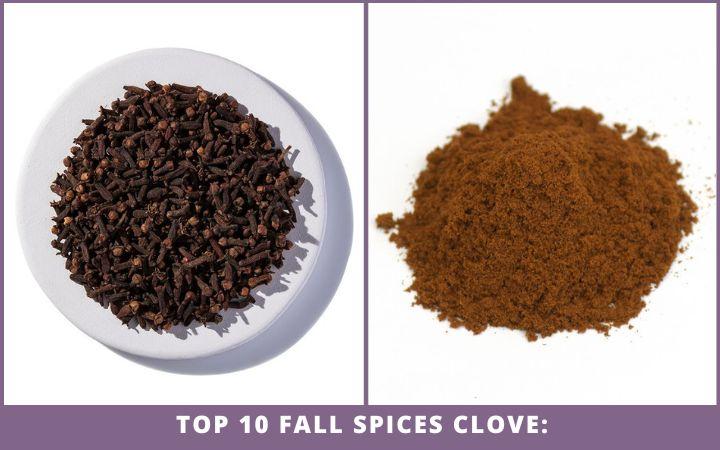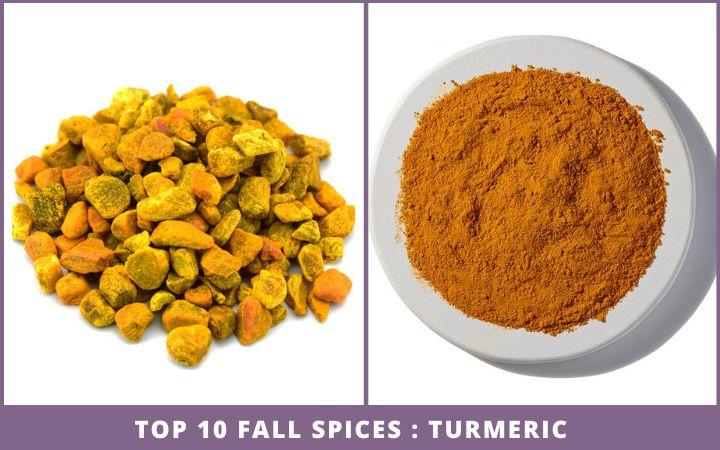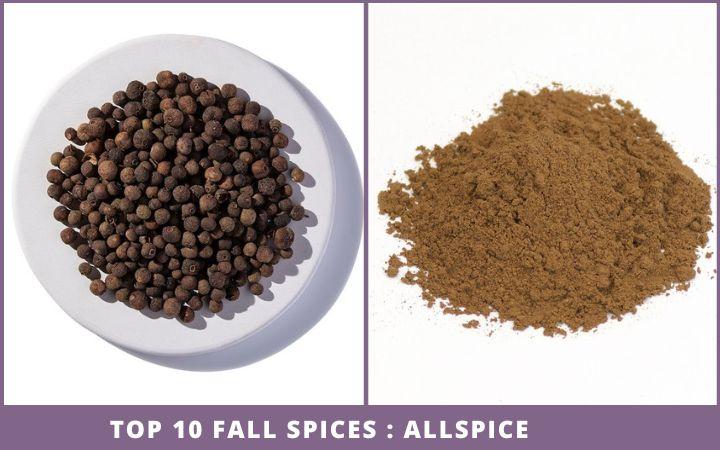As an Amazon Associate I earn from qualifying purchases. See Full Disclosure Here
As the temperature drops and nature transitions, it’s the perfect time to incorporate aromatic fall spices into your culinary adventures. In addition to adding depth and rich flavors to your dishes, fall spices also offer a range of health benefits.
This autumn, ditch those pre-mixed flavorings and explore the flavors and health benefits of these fall spices.
Benefits of Using Fall Spices During The Cooler Months
Fall is not only a season of stunning colors and cozy sweaters but also a time when spices take center stage in our culinary adventures. Incorporating spices into your fall recipes offers a multitude of benefits that go beyond adding flavor to your dishes.
1. Enhances Flavor
Spices are nature’s flavor enhancers. They add depth, complexity, and warmth to your fall recipes, transforming ordinary dishes into extraordinary culinary experiences.
From the earthy notes of cinnamon and nutmeg to the vibrant zing of ginger and cloves, spices create a symphony of flavors that delight the palate and bring a sense of comfort and nostalgia.
2. Provides A Nutritional Boost
Many fall spices are packed with essential nutrients, antioxidants, and bioactive compounds. For example, cinnamon is known to help regulate blood sugar levels and may have anti-inflammatory properties. Nutmeg offers trace minerals and may aid in digestion.
By incorporating spices into your fall meals, you infuse them with an extra nutritional punch, making them not only delicious but also beneficial for your well-being.
3. Offers Immune Support
As the colder months set in, maintaining a robust immune system becomes more important than ever. Including fall spices in your seasonal recipes may help support your immune system during the season.
Some spices such as ginger, turmeric, and cloves have been traditionally used for their potential immune-boosting properties. Ginger is known for its antimicrobial effects, while turmeric contains curcumin, a compound with antioxidant and anti-inflammatory properties.
4. Adds A Layer Of Warmth and Comfort
Fall spices have a natural ability to warm the body from the inside out.
As the temperature drops, a sprinkle of cinnamon in your morning oatmeal or a dash of cloves in your simmering stew can provide a comforting and cozy sensation. These spices have a soothing effect on the senses, helping you embrace the changing season with warmth and comfort.
5. Creates An Inviting Atmosphere
The aromatic qualities of fall spices go beyond taste. The fragrant notes of cinnamon, nutmeg, and cardamom evoke feelings of warmth, nostalgia, and happiness. It’s like aromatherapy for the soul.
The aroma of these spices can create a welcoming atmosphere, making your home feel inviting and festive during the fall season. Simply simmering a pot of spiced cider or baking a cinnamon-infused apple pie can fill the air with delightful scents that uplift the spirit.
6. Zero Calories
Looking for a way to flavor your dishes without adding those dreaded calories? Enter spices! Think of them as Fall’s Zero-Calorie Flavor Bombs.
Each tiny seed, stick, root, and rhizome is packed with flavor and nutrients but no calories. Incorporating a variety of spices into your cooking allows you to treat your taste buds without feeling guilty.
Top 10 Fall Spices & Spice Blends
1. Cinnamon: The Warm and Fragrant Spice
Cinnamon tops my list of flavorful and healthy fall spices. Its sweet and woody aroma instantly evokes a cozy atmosphere, while its sweet-spicy flavor adds warmth and depth to a variety of fall dishes, from baked goods and savory dishes to hot beverages, curries, and stews.
Cinnamon has antioxidant properties that can protect your cells from damage. It is also known to help reduce inflammation, fight infections, and control sugar levels.
On advice from my doctor, I’ve been adding ¼ teaspoon organic cinnamon powder to my coffee to manage my sugar levels. I also add a cinnamon stick to all curries, stews, and soups.
Cinnamon Essential Oil Benefits & Uses
2. Nutmeg: The Quintessential Autumn Flavor
Nutmeg is easily among the best spices for health in the fall for a long list of reasons.
Its warm, nutty, and earthy taste pairs perfectly with both sweet and savory dishes. Add a pinch of freshly grated nutmeg to your pumpkin pies, custards, or even creamy pasta sauces for an extra layer of flavor.
Nutmeg has traditionally been used to support digestion by stimulating the secretion of digestive enzymes. This makes nutrient absorption more efficient, relieves indigestion, and reduces stomach discomfort.
Nutmeg also helps reduce inflammation in the body and is thought to help improve memory and cognitive function, though more research is needed to fully understand its effects on brain health.
The aroma of nutmeg is associated with relaxation and warmth. Nutmeg essential oil is commonly used in aromatherapy to promote relaxation, reduce stress, and induce a sense of calm.
Nutmeg Essential Oil Benefits & Blends
3. Cloves: Aromatic and Versatile
Cloves are aromatic flower buds that bring a distinct intense and sweet-spicy flavor to your fall recipes.
They complement apple-based desserts, mulled beverages, and even hearty stews.
Rich in antioxidants, cloves possess antibacterial and anti-inflammatory properties, making them a valuable addition to your spice rack.
The most powerful benefit of clove is its ability to soothe toothaches. Chewing on a clove bud releases its eugenol content, which helps to numb the pain. While this should definitely not replace proper dental care, it’s a great emergency measure that helps till you can get to a dentist.
The eugenol found in clove also helps to control sugar levels.
Clove Essential Oil Benefits, Uses, & Cautions
4. Turmeric: Golden Elixir of Health
 With its vibrant golden color and warm earthy flavor, turmeric is a powerhouse of health benefits.
With its vibrant golden color and warm earthy flavor, turmeric is a powerhouse of health benefits.
Turmeric contains curcumin, a compound known for its potential anti-inflammatory and antioxidant effects. It helps reduce pain and inflammation, boosts weight loss, improves skin, and keeps sugar levels low.
From turmeric lattes and turmeric broth to seasoning vegetables and creating spice rubs for meats, there are so many easy and flavorful ways to use turmeric in fall.
5. Cardamom: Exotic and Floral
 A fragrant spice with a slightly sweet and floral flavor, cardamom has a distinct taste that complements both sweet and savory dishes, ranging from chai lattes and rice pudding to curries and baked goods.
A fragrant spice with a slightly sweet and floral flavor, cardamom has a distinct taste that complements both sweet and savory dishes, ranging from chai lattes and rice pudding to curries and baked goods.
Cardamom is high in minerals like magnesium and zinc which are essential for your health. It helps improve digestion, boosts respiratory health, and is one of the best remedies for bad breath.
6. Ginger: Zesty and Invigorating
 With its warm, earthy, and slightly spicy flavor, ginger adds a zesty kick to dishes and beverages, uplifting almost all fall recipes from soups and stir-fries to teas and baked goods.
With its warm, earthy, and slightly spicy flavor, ginger adds a zesty kick to dishes and beverages, uplifting almost all fall recipes from soups and stir-fries to teas and baked goods.
In addition to its delightful taste, ginger has long been recognized for its potential anti-nausea, anti-inflammatory, and antioxidant properties, making it a go-to spice for overall well-being.
7. Star Anise: Licorice-like Wonder
 An interesting star-shaped spice with a distinct licorice-like taste, star anise has a warm and sweet flavor that enhances both sweet and savory dishes.
An interesting star-shaped spice with a distinct licorice-like taste, star anise has a warm and sweet flavor that enhances both sweet and savory dishes.
Star anise may have potential antimicrobial and anti-inflammatory properties, making it a compelling spice to explore during fall.
Use it in apple-based desserts, mulled wines, or even braised meats to add a captivating twist.
8. Allspice: A Symphony of Flavors
Allspice is a unique spice that combines the flavors of cinnamon, nutmeg, and cloves, making it one of the best spice blends for health in fall. Its warm and peppery taste makes it an ideal addition to fall recipes such as spiced cakes, cookies, and roasted vegetables.
Besides its culinary uses, allspice may have digestive benefits and could aid in relieving muscle pain.
9. Pumpkin Spice: A Harmonious Blend
Pumpkin spice is a delightful blend of cinnamon, nutmeg, ginger, cloves, and allspice. This aromatic combination captures the essence of fall in one convenient jar.
Add pumpkin pie spice to your pumpkin-inspired creations, and hot beverages, or sprinkle it over your morning oatmeal for a comforting start to the day.
Pumpkin spice chai latte recipes are a hot favorite during this season.
10. Mulling Spice
Mulling spice is a delightful blend of spices that combines warm, sweet, and peppery flavors of cinnamon, nutmeg, and cloves with a hint of citrus, making it an ideal choice for chilly autumn evenings.
Whether you use it to spice up apple cider, mulled wine, or even added to baked goods like apple pies and pumpkin bread, mulling spice adds a cozy and nostalgic essence to fall recipes.
Its rich and comforting aroma evokes a strong sense of warmth and indulgence, making it a quintessential spice blend for the season.
How To Use Fall Spices & Spice Blends
There are many ways to use fall spices during the cooler months. Here are a few ideas to get you started:
Sprinkle a pinch of cinnamon or nutmeg shavings or powder over your coffee, tea, or other warm beverage such as spiced cider.
Add a dash of your favorite fall spices when roasting fall vegetables such as pumpkin, squash, or sweet potatoes.
Add a fall spice mix to your cake or cookie batter to add a delightful spicy twist to your favorite fall recipes. Think pumpkin spice cookies and snickerdoodles.
Dust a smidgen of spice to add a touch of flavor and warmth to your breakfast pancakes and muffins.
Experiment by mixing different spices together to create a variety of flavorful marinades for all types of dishes. Make sure to keep a record of the spice combinations so you can repeat your hits and discard the misses.
How To Store Fall Spices So They Stay Fresh Longer
Storing your spices in a cool, dark, dry area is key to keeping them fresh longer. Exposure to heat and moisture will degrade the quality and flavor prematurely.
Use airtight containers, such as glass jars, plastic bags, or zip-top bags, to protect your spices from oxygen and moisture.
It’s best to buy spices in smaller quantities as they lose their potency and aroma over time even when stored properly. As a guide, check the expiration date on the packaging.
You can store larger quantities in the fridge but the downside is refrigeration causes condensation and clumping.
A general rule of thumb is that whole spices can last for up to four years, ground spices for two to three years, and dried herbs for one to three years.
Where to Buy Fall Spices
My top two places to buy spices are Starwest Botanicals and Amazon.com.
Starwest Botanicals is my preferred online ‘spice market’ for many reasons. For one thing, I don’t have to scour hundreds of products to find the one I want. This online herb ad spice store stocks a few select, high-quality whole spices as well the powdered variety of each spice. Aside from quality, the one big factor in their favor is the eco-friendly spice packaging.
Amazon wins because of its larger range of spices of all types from everyday fall herbs and spices to exotic Asian spices. Here you can find organic spices in individual bottles as well as organic spice sets. You can also find a wide range of spice organizers that save space and also make it easier to find the spices you want.
Should you buy whole spices or powdered spices?
Generally, whole spices are better as their components remain intact longer. But…they can be more tedious to use as you will need to grind them up and make a powder to use in most dishes.
Whether you buy whole or powdered spices will depend on what you will use them for.
Whole spices are great for soups, stews, roasts, and other simmering dishes.
Powdered spices are better for sprinkling over beverages and desserts or adding to cake and cooking mixes.
I use a lot of spices in my cooking and buy small quantities of both – the whole and powdered versions of each spice. But I know I’ll use them a lot so they never go to waste.
The one spice I never buy whole is turmeric. The dried rhizome is hard as stone and you will need a specialized grinder to powder it. Then too, it’s impossible to get it in a finely ground form. You’ll have to put it through a sieve to keep the hard bits out.
Which fall spice is your favorite and how do you use it? Share your ideas with us in the comments below.
Related: The Magic of Christmas Spices: Adding Flavor and Warmth to Your Holiday Season

Disclaimer: This information is not intended to serve as medical advice. Please consult your doctor before using any natural medication or if you experience any unusual symptoms. See Full Disclaimer here.










